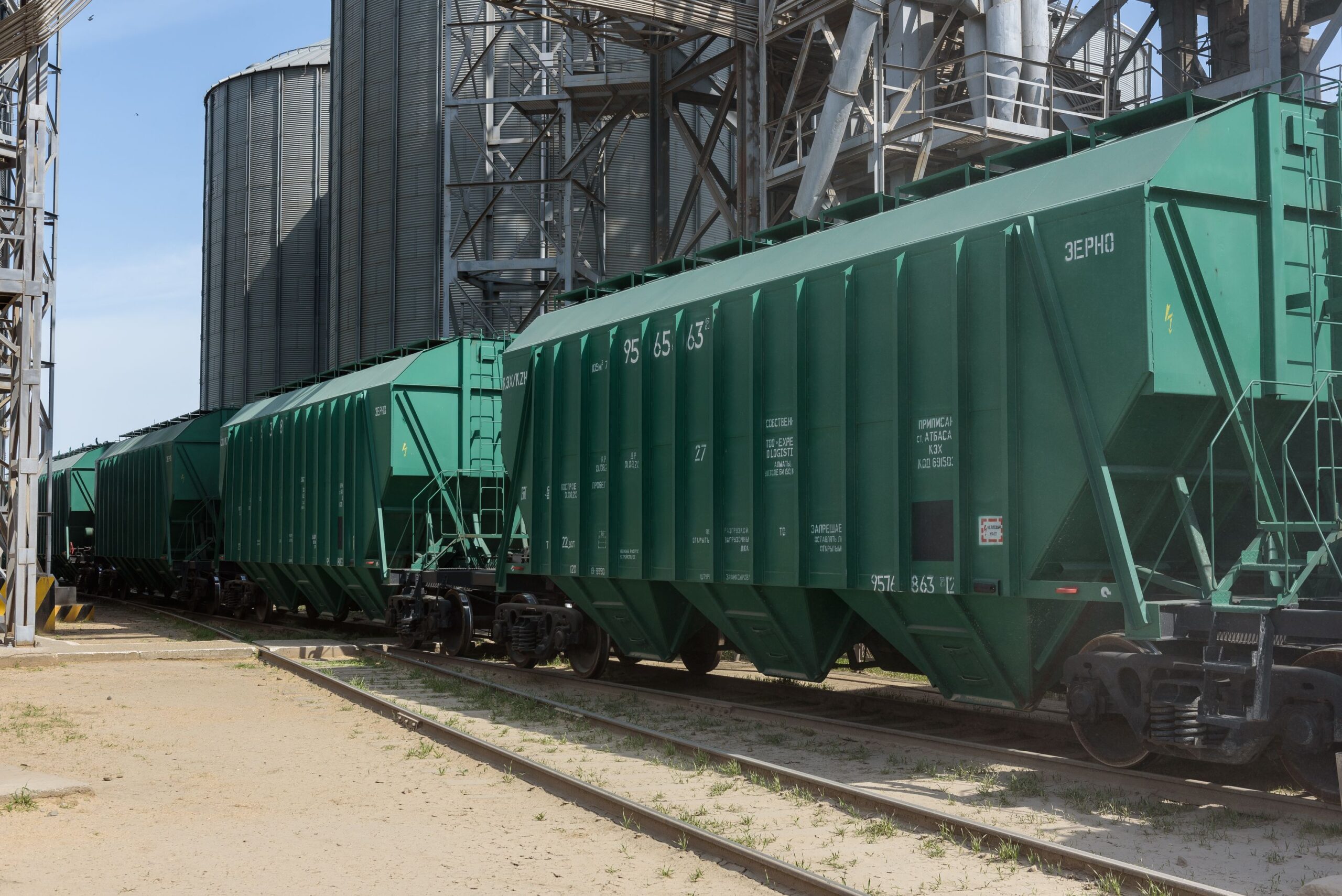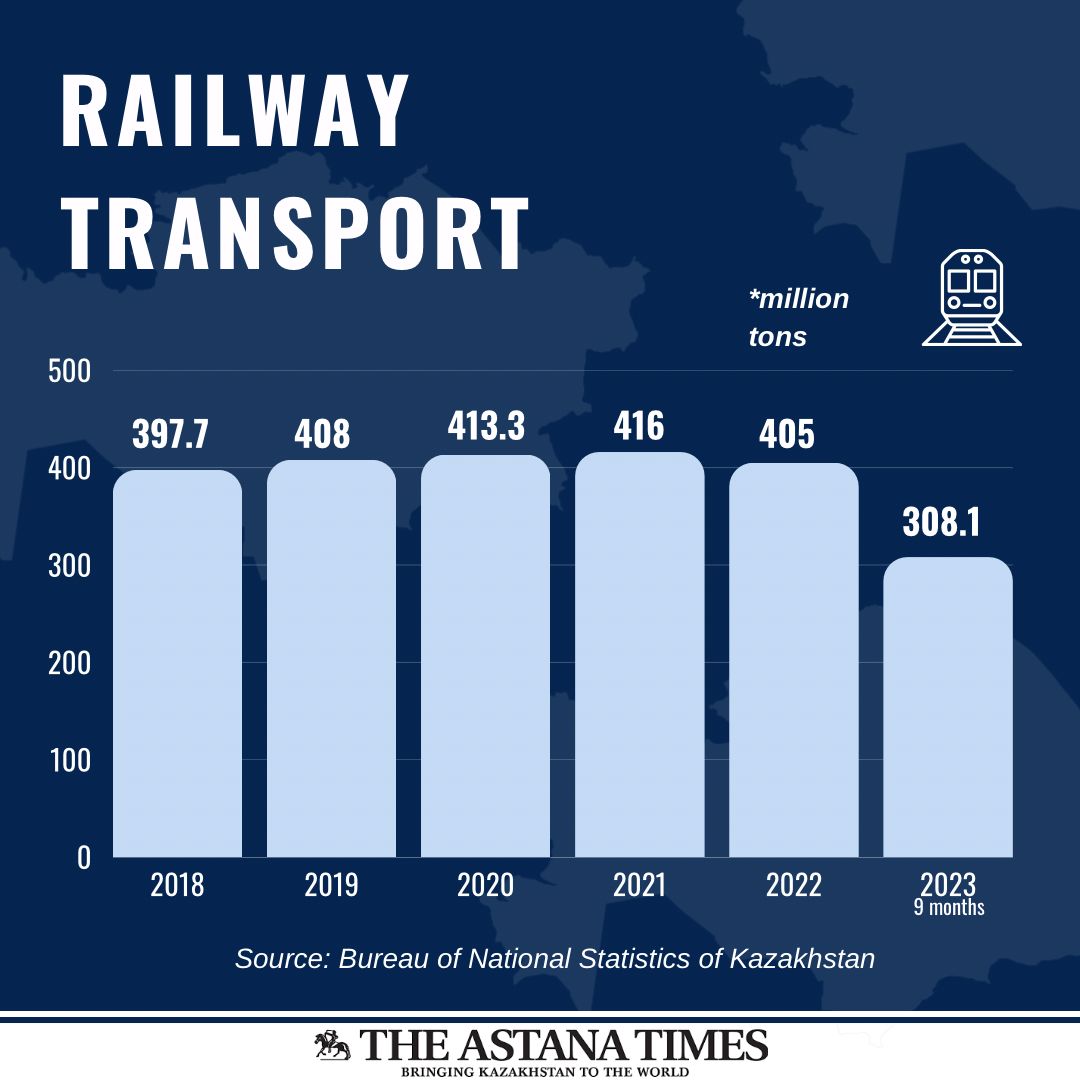ASTANA – Amidst a complex web of geopolitical shifts, Kazakhstan is emerging as the veritable powerhouse in Eurasia’s transport and logistics landscape. In his previous state-of-the-nation address on Sept. 1, President Kassym-Jomart Tokayev set an ambitious objective for Kazakhstan to become what he called a “full-fledged power” in this field.

Kazakhstan Temir Zholy freight carries grain. Photo credit: rail-news.kz
With its vast landmass and strategic location at the crossroads of continents, Kazakhstan’s ambitious goal is becoming a reality, contingent upon strategic investments.
Kazakhstan, the world’s largest landlocked country, possesses significant untapped potential in transport and logistics. Its strategic geographical location at the crossroads of Europe and Asia, abundant natural resources, and proactive infrastructure development plans make it a promising hub for regional and international trade.
In his Sept. 1 address, Tokayev tasked the government to bring the share of the transport and logistics sector’s contribution to the national GDP to 9% within the next three years. As of 2022, the figure stood at 6.2%, with a slight dip to 5.9% in the first half of 2023.
Kazakhstan has invested $35 billion in the transport and logistics sector in the past 15 years. The nation boasts a network of transit, transcontinental corridors, and routes. Thirteen international corridors pass through Kazakhstan, including five railways and eight auto corridors.
In February, the Kazakh government adopted the concept for the development of transport and logistics potential until 2030. The document provides a vision for the development of various transport modalities, including rail, road, maritime, and air, as well as logistics.
According to the latest government data, in the first nine months of 2023, 725.6 million tons of cargo were transported in Kazakhstan, 3.2% more than in the same period last year.
Transit traffic on the rise
Experts suggest that Kazakhstan is well-placed to benefit from the increased movement of goods between Europe and Asia.

Kazakhstan boasts significant potential to be a transit hub. Photo credit: The Astana Times
According to the Kazakh Ministry of Transport, in the first eight months of 2023, Kazakhstan’s transit traffic surged to 20.7 million tons, up by 25% compared to the same period last year. Of this, rail transport accounted for 18.5 million tons, with transit container traffic comprising 974,500 twenty-foot equivalent units (TEUs).
Transit via roads hit 2.26 million tons, 18.9% higher than last year.
In 2022 alone, cargo transit reached 26.8 million tons. Between 2015 and 2021, the average annual growth in transit traffic by all modes of transport was 14.8%.
By 2030, the volume of transit through the territory of Kazakhstan will increase to 35 million tons, in accordance with its strategic plan for the development of the nation’s transport and logistics capacity.
Railways
In 2022, 405 million tons of cargo were transported by Kazakhstan’s railway transport, according to the Bureau of National Statistics. In just the first nine months of 2023, this amount has reached 308.1 million tons.

The majority of cargo is transported by railways. Photo credit: The Astana Times
Nearly 90% of transit cargo is transported by rail. There are five international freight corridors passing via Kazakhstan.
One of them is the northern corridor of the Trans-Asian Railway, which in Kazakhstan goes along Dostyk/Altynkol station – Moiynty – Astana – Petropavl. Container trains pass through this route from China to Europe.
Additionally, the Central Asian corridor of the Trans-Asian Railway serves as a vital link for transit traffic between Russia and the nations of Central Asia. Within Kazakhstan, this route originates from Saryagash in the south, proceeding through Arys, Kandyagash, and reaching Ozinki.
The route along Dostyk/Altynkol station – Aktogay – Almaty – Arys – Saryagash is part of the southern corridor of the Trans-Asian Railway. It connects China and Southeast Asia with the countries of Central Asia and the Persian Gulf.
Kazakhstan is also part of the TRACECA (Transport Corridor, Europe, Caucasus, Asia) program, which encompasses 13 countries. Kazakhstan’s segment in this corridor starts at the Dostyk/Altynkol station, continuing through Moiynty and Beineu, before reaching the ports of Aktau and Kuryk in the western part of the country.
North-South corridor, a 7,200 kilometers long route that connects Russia with Iran, Gulf states, and India, also runs through Kazakhstan. Experts say Kazakhstan’s participation opens up access to the seaports of the Persian Gulf, providing an opportunity to build transit traffic routes in the direction of India, one of the world’s largest consumer markets.
Moreover, the Kazakhstan-Turkmenistan-Iran railway line, which is the eastern branch of the North-South corridor, creates a direct link from China to Iran, passing through Kazakhstan. In the first eight months of 2023, cargo traffic along this route to Iran saw a 25% increase from the previous year, with 1.4 million tons transported.
To develop the North-South corridor, the sides are working to improve infrastructure and terminal facilities, increase rolling stock, remove administrative barriers, and create favorable conditions for carriers.
Trans-Caspian International Transport Route
Discussions on Kazakhstan’s transport and logistics sector frequently underscore the significance of the Trans-Caspian International Transport Route (TITR), also known as the Middle Corridor. This route has garnered attention from its founding nations and beyond, including interest from the European Union and the United States.

Trans-Caspian International Transport Route passes via Kazakhstan. Photo credit: The Astana Times
TITR is a multimodal corridor with a length of 6,180 kilometers. In the first eight months of 2023, the volume of cargo transshipped through the Aktau and Kuryk seaports reached 1.74 million tons, marking an 85% increase compared to the same period the previous year.
However, there has been a 37% reduction in container transportation via TITR within the same timeframe, with a total of 12,600 TEUs recorded. This downturn is attributed to a shift in cargo to southern routes due to lower sea freight costs and the cessation of Chinese subsidies to shippers using the TITR.
Overall, the throughput capacity of TITR stands at six million tons, including 80,000 TEU.

President Kassym-Jomart Tokayev repeatedly emphasizes the need to unlock the potential of TITR, including through partnerships not only with the founding members but also beyond, including the European Union. Photo credit: The Astana Times
Nevertheless, there are numerous infrastructure bottlenecks along the entire corridor. To address them and advance the development of the corridor, Kazakhstan and Georgia signed a bilateral roadmap, and a trilateral agreement was also established between Kazakhstan, Azerbaijan, and Türkiye in Aktau in November 2022.
By 2027, the countries expect to increase the throughput capacity from six million tons to 10 million tons per year and reduce delivery times to 14-18 days, including five days across Kazakhstan.
Plans also include streamlining and digitizing administrative procedures at the border, checkpoints, ports, and other infrastructure facilities and expanding the geography of corridor participants by attracting new partners to the route.
According to the Kazakh government, an intergovernmental agreement with China focusing on the development of TITR, particularly for container trains between China and Europe, is poised for signing. This agreement is set to outline projected annual cargo volumes through the corridor, facilitate the exchange of tracking data for rolling stock within the borders of both nations and provide China with support in optimizing the capacity of main pipelines and port infrastructures.
Projects have been launched to construct a Kazakh logistics center in the dry port of Xi’an in China, a multimodal terminal in the port of Poti in Georgia, and a trade and logistics hub in the Almaty Region.
Kazakhstan’s efforts to develop TITR
Kazakhstan is working to complete the construction of the second track on the Dostyk-Moiynty section, which spans 836 kilometers. According to the Kazakh Ministry of Transport, this project will increase the volume of transit traffic between China and Europe by boosting the capacity of the section fivefold and increasing the speed of transportation to 1,500 kilometers a day from the current 800 kilometers a day.

The construction of the second track on the Dostyk – Moiynty railway section began on Nov. 17, 2022. Photo credit: primeminister.kz
The project, which will be commissioned in 2025, is valued at 543 billion tenge ($1.1 billion) and is financed from the National Fund on a repayable basis by purchasing infrastructure bonds from the Samruk Kazyna Sovereign Wealth Fund.
Additionally, the new Darbaza-Maktaaral railway line, connecting Kazakhstan and Uzbekistan, aims to alleviate congestion at the Saryagash station, integrate the Maktaaral region with the main rail network, and enhance transit connections to Iran, Afghanistan, Pakistan, and India. The feasibility study for this project was completed in October.
With the implementation period from 2024 to 2025, the cost of the project is estimated at 250 billion tenge ($523.1 million). The funding is also planned from the National Fund.
Furthermore, Kazakhstan intends to construct the Bakhty-Ayagoz railway line, which will relieve pressure on the border stations of Dostyk and Altynkol and boost the cargo capacity between China and Kazakhstan by an additional 20 million tons. This 272-kilometer line is projected to cost 577.5 billion tenge ($1.2 billion), with funding sourced from a loan provided by the Eurasian Development Bank, although private investments are also under consideration.
Key ports
Kazakhstan is also making strides in the development of its key ports, including the Aktau seaport situated on the eastern Caspian Sea coast. It serves as a crucial junction for multiple global transportation routes. This strategic location facilitates continuous transportation of various commodities, including dry cargo, crude oil, and petroleum products, in different directions.

The port on the eastern coast of the Caspian Sea in the Mangystau Region was commissioned in 2017 following two years of construction. Photo credit: primeminister.kz
According to the transport ministry, an additional container hub at the Aktau seaport with a capacity of more than 200,000 TEU will be commissioned in 2025. The cost of the project is 20.2 billion tenge ($42.3 million). A search for an investor is underway.
Similarly, a Sarzha multifunctional sea terminal, which was inaugurated on Sept. 29, was built by Kazakh company Semurg Invest at the port of Kuryk. The project includes a grain terminal with a capacity of one million tons, an oil terminal with a capacity of 5.5 million tons, and a universal terminal with a capacity of three million tons.
Road corridors
Eight international road corridors pass through the territory of Kazakhstan, with a total length of 13,200 kilometers.
One of the key highways is Western Europe – Western China with a total length of 2,747 kilometers. Kazakhstan’s section was reconstructed between 2009 and 2017.
In addition, several corridors pass through Kazakhstan that connect China and Europe, including one that starts in China, then goes through Kazakhstan’s Semei and Pavlodar, before reaching Russia’s Omsk. Spanning 1,116 kilometers, this corridor is one of the main routes of the eastern region, along which transit from China through the territory of Kazakhstan to Europe is carried out.
In 2023, Kazakhstan plans to complete the reconstruction of an 893-kilometer corridor running from Aktobe, Atyrau, then to Russia’s Astrakhan. By 2025, the country will also reconstruct Atyrau – Uralsk – Russia’s Saratov route with a length of 587 kilometers.
At a press conference in Astana on Oct. 23, Kazakhstan’s Deputy Foreign Minister Roman Vassilenko said Kazakhstan welcomes investments from the EU, the U.S., Russia, and China, and other countries of the region, as well as from international financial institutions, to achieve its objectives and advance its national interests.


